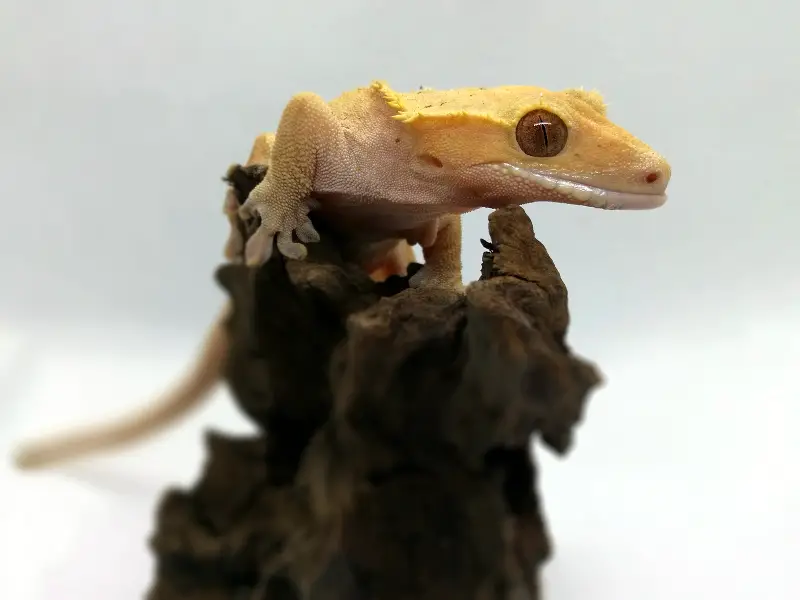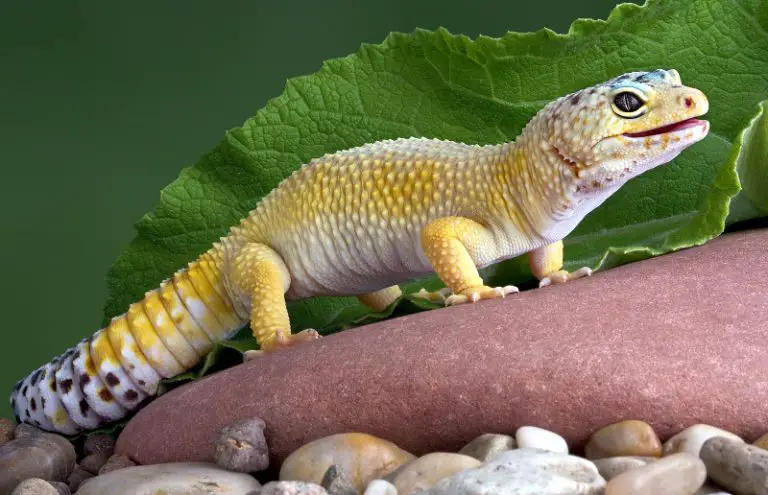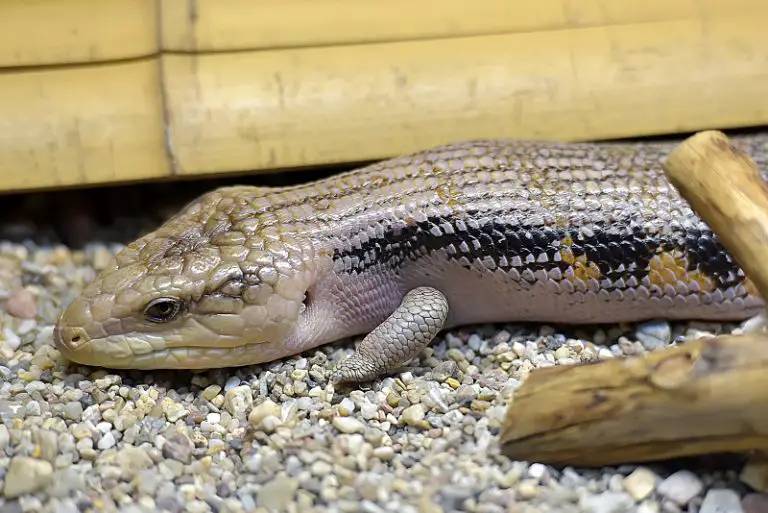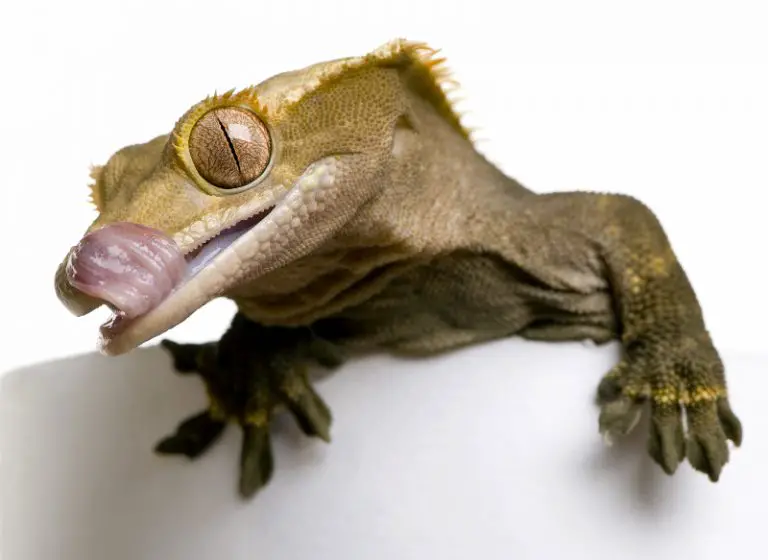Yellow Crested Gecko: Everything You Need To Know

Crested geckos come in a variety of different colors: browns, tans, black-like colors, reds, oranges, olives, and yes…yellow. Some geckos are a solid color of yellow or cream, but most will have some kind of dark patterning as well. This is a full guide to yellow crested geckos.

Do you also want to learn more about why crested geckos are the colors they are? Are you curious how all the variations look? Keep reading to find out as I’ll cover this too.
Contents
Table of Contents
What Is A Crested Gecko?
Once thought to be extinct in the wild, crested geckos are one of the most popular lizard species to be kept as pets. The little lizards hadn’t been seen for years, leading scientists to believe they were extinct. Remarkably, they were “rediscovered” in 1994 on the island of New Caledonia in the South Pacific.
Ever since then, they have become popular in the legal pet trade. Breeders have been working with them for years to come up with the best patterns and colors.
They are enjoyed by both beginners and experts alike.
Beginners love them because they’re easy to care for. They don’t like to be handled, so you simply need to make sure their habitat suits them, and that they’re receiving the best diet. They also don’t take up a lot of space.
Expert reptile owners also love these lizards because of their relaxed nature and interesting colors. Crested geckos are peaceful and docile, but they are also very active and can often be seen climbing around their enclosure.
The best part, though, is their coloration. Crested geckos do come in tones of yellow, but they also come in a variety of other colors. Red, orange, tan, brown, olive… yellow. They come in so many colors and patterns that make them simply beautiful to watch.
Is There A Yellow Crested Gecko?
Crested geckos come in a variety of earthy tones, and yellow is one of them. Other colors include browns, black-like colors, tans, oranges, reds, and olives.
Technically, yes, there are yellow crested geckos, but that’s not really how we refer to them. Instead, we have different morphologies of crested geckos. Morphologies are just physical traits that we use to break a species into categories.
Crested geckos are polymorphic, meaning that they have several physical characteristics that can get them placed into a certain category. Most reptile species are not polymorphic, making crested geckos unique.
While there are yellow crested geckos, most are not solidly yellow. There are solid colored crested geckos called patternless geckos, but these aren’t the only options. In fact, crested geckos come in so many colors and patterns that yellow is often one of many colors found on a single gecko.
What Is A Yellow Dalmatian Crested Gecko?
A yellow Dalmatian crested gecko is basically just what you’d think it is. The base color of its body is usually a solid yellow or cream color. The rest of their body is going to be covered in variations of small and large spots, like a Dalmatian.
Usually, these spots are going to be black, but they can also be any of the earthy tones we described above.
What Is A Yellow Tiger Crested Gecko?
Similar to the Dalmatian variety, yellow tiger geckos will have a yellow or cream based body. Rather than having spots, they will have long, jagged stripes up and down their body. Again, these stripes are usually a dark brown or black-like color, but they can come in other colors as well.
What Is A Yellow Flame Crested Gecko?
This is one of the most striking pattern variations for yellow crested geckos. The head and the dorsal region of the gecko’s body will be a yellow or cream color, marked by darker flame-like patterns. The “flames” may also appear up and down the sides of the gecko.
What Is A Yellow Harlequin Crested Gecko?
A yellow harlequin gecko is very similar to the flame gecko. They are technically the same morphology, but harlequins have more “flames” than the flame geckos do. The flame-like patterns will appear up and down the lizard’s limbs in addition to its body. This is a trait not found in flame geckos.
What Is A Yellow Pinstripe Crested Gecko?
Yellow pinstripe crested geckos are also very interesting to look at because of their bright colorations. Their bodies will be a yellow or cream color. Their pinstripes will be similar in color, but they will be even lighter, their coloration standing out more.
The pinstripes refer to the two lines of spiky scales that run down the gecko’s back. These spikes begin above their eyes, looking like eyelashes, and run down the sides of their back.
These spikes stand out to begin with. Adding a bright yellow or cream coloration to them simply helps them stand out more.
What Makes A Crested Gecko Yellow?
What causes a crested gecko to take on a yellow coloration? This really comes down to their natural colors in the wild, how they were bred, and how and when they change colors.
In The Wild
Some of the crested geckos natural colors in the wild are yellow and cream. It makes sense then that bred geckos would retain those same colors.
Breeding
Breeders breed their geckos in a way that makes their coloration more vibrant than you would find in the wild. So, many geckos will still have this same coloration, but it will stand out even more.
Breeding crested geckos is a tricky process because they are polymorphs. Unlike other species of lizards, crested geckos can’t really be bred the Mendelian way (like humans). Instead, their colors and patterns are going to turn out more random.
Many times, breeders don’t know what kinds of crested geckos they’ll end up with, although there are some ways for them to control the process to an extent. To learn more about crested gecko breeding, check out this impressive guide.
Changing Colors
Like many other lizard species, crested geckos can also change their color at will. They will do this to communicate, blend in with their surroundings, or to show their mood. We’ll go more in depth on this later.
What Are Crested Gecko Morphs And Traits?
Crested geckos come in all different colors and patterns — that’s what makes them so popular. There are three main morphologies: patternless, tiger, and fire morphs. Each of these morphs are then broken down further into individual traits.
Watch this COMPLETE Guide to Crested Gecko Morphs!
Patternless
As the name suggests, patternless geckos have no pattern on their body. Instead, they are covered by a single, solid color of brown, olive, tan, black-like, orange, red, and yellow.
Fully white and black geckos do not exist. The closest colors you will find to these are cream and a dark grey-brown.
Bi-Color
These are another type of patternless gecko, although their bodies have two colors instead of one. The base color of their bodies is usually a darker coloration, while their head and dorsal region will be a lighter color.
Tiger
These crested geckos have a solid base color that is marked by darker “tiger stripes”. The base colors and the stripes can come in all of the colors discussed above. However, it’s more common for the base color to be lighter than the stripes.
One of the most popular base colors for tiger geckos is yellow or cream. This lighter coloration marked by dark stripes makes the gecko stand out remarkably.
Red tiger geckos are also very popular, although they are not true tiger geckos. They have their stripes when they are younger, but as they fully become an adult, they lose the tiger markings. In the end, you’re left with a fully red gecko.
Brindle
Brindle crested geckos are another kind of tiger gecko. The only difference is that brindles have more stripes than tigers do. The intensity of the stripe’s colors also varies more greatly.
Flame
The base color of these geckos is usually darker, while the head and dorsal region are usually a light, cream or yellow color. The creamy head and back of the gecko is marked by flame-like patterns. Sometimes, the flames can be found come up the side of the gecko as well.
Harlequin
Harlequin geckos are the same as flame geckos, but the “flames” are more prominent, and are more in number. They will also be found up and down the limbs of the gecko, a trait that is not found in flame geckos.
The solid color of the gecko is usually darker as well. Most often, the base color will be some variation of red or a black-like color. The flames are usually yellow, orange, or cream.
Extreme Harlequin
These have even more patterning than flame and harlequin geckos. To be considered an “extreme” harlequin, the flame patterning must cover at least 60% of their body.
Other Traits
Some crested geckos are classified even further based on individual traits. Some other patterns of crested geckos include pinstripes, lateral stripes, Dalmatian spots, white spots, and lavender.
Some of these variations were covered at the beginning of this article, but if you would like more information, check out this article.
Can Geckos Change Their Color?
Like many lizards, crested geckos can change their color. Unlike some lizards, they can’t do this of their own free will, but color changing can be triggered.
Some change color all the time, while others will never change in their lifetime. Whether you gecko changes color frequently or not at all doesn’t mean there’s anything wrong with it. Their bodies are all different, and they will all react differently.
Being able to change color has an evolutionary advantage for crested geckos, and they take advantage this ability for a number of reasons.
The most common reasons they change color is due to age, environmental stimulants, mood, or shedding.
Age
As with any animal, crested geckos will go through changes as they grow from their juvenile to adult stages. Most juvenile crested geckos will be born with red or orange colors that are very bright.
Hatchlings will also be devoid of patterns or spots. If they have any kind of pattern, it will be remarkably subdued.
Because of this common juvenile coloration, it’s not possible for breeders to tell what kind of gecko it will turn into. After a couple months, as the gecko ages, it will gradually begin to change into its adult colors.
This process can take several months to complete. Crested geckos won’t usually assume their full adult coloration until they are a year old.
The Environment
When an adult crested gecko changes color, it’s called “firing up” or “firing down”. These processes are most related to their environmental surroundings or their mood.
“Firing up” is associated with brighter, more vibrant colors. Most geckos will begin this process when they are on high alert.
“Firing down” is associated with dark, more subdued colors. This happens when the gecko is more calm, or is sleeping.
Here are some of the most likely scenarios that will cause your gecko to “fire up” or “fire down”:
- Higher Temperatures (above 85 degrees Fahrenheit) can cause your gecko to increase in vibrancy. Crested geckos are very sensitive to high heat, and shouldn’t be exposed to temperatures this high for long.
- Ideal temperatures for crested geckos are between 72-75°F. If they are “firing up” because they are exposed to high temperatures, they are likely stressed.
- A crested gecko’s mood can also cause it to “fire up” because they’re more likely to do so when they’re stressed, angry, or afraid.
- The amount of lighting kept in the tank can also effect how vibrant your crested gecko is. At nighttime when the lights are turned down, they will “fire up”, becoming darker with their surroundings.
- This is thought to be because the geckos are nocturnal and are more active at night.
- It could also be because the darker colors allow them to blend in with their surroundings better. This would keep them safer if they lived in the wild.
- Humidity reaching 70% or higher can cause a crested gecko to “fire up”.
- Humidity should be kept about 60% during the day.
- Humidity should be kept at about 70-80% at night.
- Crested geckos are more likely to “fire up” at night.
- When a crested gecko sleeps, it becomes more relaxed and will “fire down” into darker, subdued colors.
- When a crested gecko is ready to shed, their old skin becomes greyer and dull. After the old skin is gone, it will go back to being it’s usual, vibrant self.
Conclusion: Yellow Crested Gecko
Yellow geckos most certainly are a thing, although most will have a variety of colors. Crested geckos come in colors of reds, browns, black-like colors, oranges, olives, tans, and yellows. There are so many colors and patterns to choose from.
Whatever color a crested gecko winds up being is determined by their genetics, their breeding, and their environment. One thing’s to be for certain — whatever color you choose — you’ll have a beautiful new pet.
Click here to learn about green crested geckos or here to find all our gecko guides. Read more about the types of crested geckos here.


![Can Leopard Geckos Swim? [Must Read]](https://allourcreatures.com/wp-content/uploads/2021/12/cute-leopard-gecko-768x507.jpg)



![Can Geckos Swim? [Must Read]](https://allourcreatures.com/wp-content/uploads/2021/12/gecko-cool-768x513.jpg)